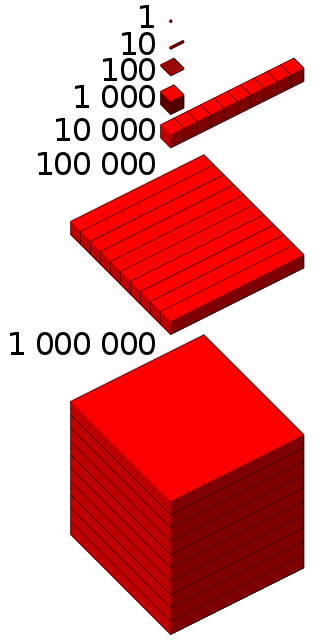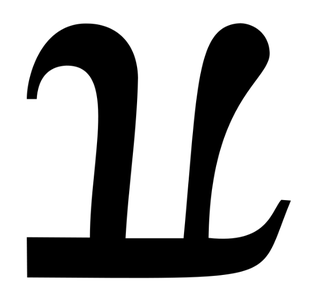Related Research Articles
A palindromic number is a number that remains the same when its digits are reversed. In other words, it has reflectional symmetry across a vertical axis. The term palindromic is derived from palindrome, which refers to a word whose spelling is unchanged when its letters are reversed. The first 30 palindromic numbers are:
11 (eleven) is the natural number following 10 and preceding 12. It is the first repdigit. In English, it is the smallest positive integer whose name has three syllables.
In recreational mathematics, a repdigit or sometimes monodigit is a natural number composed of repeated instances of the same digit in a positional number system. The word is a portmanteau of "repeated" and "digit". Examples are 11, 666, 4444, and 999999. All repdigits are palindromic numbers and are multiples of repunits. Other well-known repdigits include the repunit primes and in particular the Mersenne primes.
27 is the natural number following 26 and preceding 28.
69 (sixty-nine) is the natural number following 68 and preceding 70. An odd number and a composite number, 69 is divisible by 1, 3, 23 and 69. 69 is a semiprime because it is a natural number that is the product of exactly two prime numbers, and an interprime between the numbers of 67 and 71. Because 69 is not divisible by any square number other than 1, it is categorised as a square-free integer. 69 is also a Blum integer since the two factors of 69 are both Gaussian primes. In number theory, 69 is a deficient number, arithmetic number and a congruent number.
73 (seventy-three) is the natural number following 72 and preceding 74. In English, it is the smallest natural number with twelve letters in its spelled out name.
1000 or one thousand is the natural number following 999 and preceding 1001. In most English-speaking countries, it can be written with or without a comma or sometimes a period separating the thousands digit: 1,000.
2000 is a natural number following 1999 and preceding 2001.
10,000 is the natural number following 9,999 and preceding 10,001.

1,000,000, or one thousand thousand, is the natural number following 999,999 and preceding 1,000,001. The word is derived from the early Italian millione, from mille, "thousand", plus the augmentative suffix -one.

1,000,000,000 is the natural number following 999,999,999 and preceding 1,000,000,001. With a number, "billion" can be abbreviated as b, bil or bn.
100,000 (one hundred thousand) is the natural number following 99,999 and preceding 100,001. In scientific notation, it is written as 105.
A cyclic number is an integer for which cyclic permutations of the digits are successive integer multiples of the number. The most widely known is the six-digit number 142857, whose first six integer multiples are
An undulating number is a number that has the digit form ABABAB... when in the base 10 number system. It is sometimes restricted to non-trivial undulating numbers which are required to have at least three digits and A ≠ B. The first few such numbers are:
10,000,000 is the natural number following 9,999,999 and preceding 10,000,001.
100,000,000 is the natural number following 99,999,999 and preceding 100,000,001.
In number theory, a left-truncatable prime is a prime number which, in a given base, contains no 0, and if the leading ("left") digit is successively removed, then all resulting numbers are prime. For example, 9137, since 9137, 137, 37 and 7 are all prime. Decimal representation is often assumed and always used in this article.
20,000 is the natural number that comes after 19,999 and before 20,001.

Belphegor's prime is the palindromic prime number 1000000000000066600000000000001 (1030 + 666 × 1014 + 1), a number which reads the same both backwards and forwards and is only divisible by itself and one. It was discovered by Harvey Dubner. The name Belphegor refers to one of the Seven Princes of Hell, who was charged with helping people make ingenious inventions and discoveries. "Belphegor's prime" is a name coined by author Clifford A. Pickover. The number itself contains superstitious elements that have given it its name: the number 666 at the heart of Belphegor's Prime is widely associated as being the Number of the Beast, used in symbolism to represent one of the creatures in the Apocalypse or, more commonly, the Devil. This number is surrounded on either side by thirteen zeroes and is 31 digits in length (thirteen reversed), with thirteen itself long regarded superstitiously as an unlucky number in Western culture.
References
- ↑ De Geest, Patrick. "World of Palindromic Primes". World!Of Numbers. Retrieved 1 April 2023.
- ↑ Chris Caldwell, The Top Twenty: Palindrome
- ↑ William D. Banks, Derrick N. Hart, Mayumi Sakata, February 1, 2008 "Almost All Palindromes Are Composite"
- ↑ "Palindromes in Some Smarandache-Type Functions". Jurnal Matematika MANTIK Vol. 8, No. 1, 2022, pp.1-9, by Hary Gunarto, S.M.S. Islam and A.A.K. Majumdar. June 2022. Retrieved 8 October 2023.
- ↑ See Caldwell, Prime Curios! (CreateSpace, 2009) p. 251, quoted in Wilkinson, Alec (February 2, 2015). "The Pursuit of Beauty". The New Yorker. Retrieved January 29, 2015.
- ↑ Paulo Ribenboim, The New Book of Prime Number Records
- ↑ "Even more pi in the sky: Calculating 100 trillion digits of pi on Google Cloud". Google Cloud Blog. Retrieved 2022-10-13.
- ↑ "Sigma Geek". SigmaGeek. Retrieved 2022-10-13.